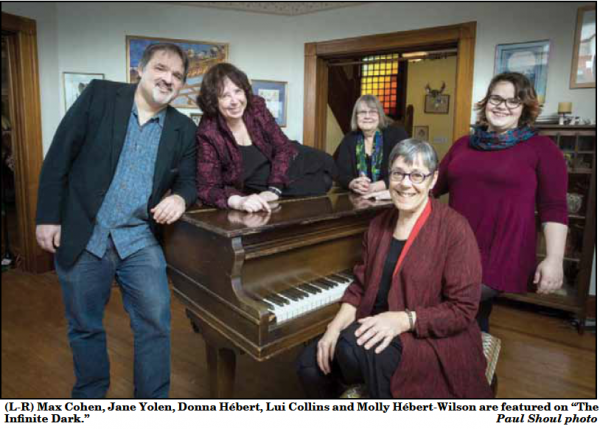April 1, 2019

‘The Infinite Dark’ on tap at Boston College April 4
)A fascinating union of song, music, poetry, and story-telling – with influences from Irish, Scots, and European folklore and tradition – is to be found in “The Infinite Dark,” a project centered on the works of award-winning, New York Times bestselling author/poet Jane Yolen and a trio of Western Massachusetts musicians: Donna Hébert (fiddle, vocals), Lui Collins (piano, banjo, vocals), and Max Cohen (guitar, percussion, vocals), known collectively as The 3 Ravens band.
Yolen and company will present “The Infinite Dark” on April 4 at Boston College, as part of the BC Center for Irish Program’s Gaelic Roots series; the event, which is free, takes place at 6:30 p.m. in Connolly House (300 Hammond Street) on the university’s Chestnut Hill campus.
In addition to her poetry, Yolen has written fantasy, science fiction and children’s books, including “How Do Dinosaurs Say Goodnight?” which debuted at number 10 on the New York Times bestseller list. Among the honors she has received are a Caldecott Medal, two Nebula Awards, the World Fantasy Award, the Jewish Book Award, and the World Fantasy Association’s Lifetime Achievement Award.
On “The Infinite Dark,” Yolen’s poems and lyrics – many of them from her collection “The Last Selchie Child” – take a fresh look at the stuff of legends and folk tales, including selkies, mermaids, witches, and even Goldilocks. Some of the works are recited by Yolen; others are set to music and sung by Collins and Hébert; these are supplemented by a pair of songs written by Cohen. Adding to the texture are instrumental passages, including a jig from the Orkney Islands, “The Fisherman’s Song for Attracting Seals,” and the Irish air, “The Mermaid.” (Guest performers are Sarah Bauhan on whistle and Molly Hébert-Wilson on vocals.)
It’s the latest turn in a long and eventful career for Hébert, who has studied and played a variety of traditional fiddle styles, including Irish, Scottish, French-Canadian, and Canadian Maritime, working with distinguished musicians such as Seamus Connolly, Joe Cormier, Graham Townsend, and Allan Block. Her many ventures have included a project to document and present the music of Vermont fiddler Louis Beaudoin; a stint with Rude Girls, an all-female band that fused traditional music styles with contemporary songs on social issues from women’s perspectives; and directing the Great Groove Band, an ensemble for young musicians that assembles at the Old Songs and Philadelphia Folk festivals.
She has mentored eight Franco-American fiddle apprentices through the National Endowment for the Arts’ Master-Apprenticeship program and was named a Massachusetts Artists’ Fellow in the Folk Arts.
Hébert discussed “The Infinite Dark” in a recent interview with the BIR.
Q. How and when did you cross paths with Jane Yolen?
A. I met Jane seven years ago at a friend’s party. We bonded instantly as women artists. She invited me over for tea and sent me home with signed copies of books that would change my life. Lui Collins met Jane through her poem “The Ballad of the White Seal Maid,” which Lui set to music before actually meeting Jane. Both Lui and I agree that setting Jane’s poetry to music happens naturally. They come out of our mouths as songs when we read them.
On “The Infinite Dark,” Lui has written music for five of Jane’s poems, while I have one. Max has scored some of Jane’s and written two of his own. Max engineered the whole thing and his guitar underpins Jane’s poetry with perfection. Jane calls us “her band,” and just celebrated her 80th birthday. She’s an inspiration to us all.
Q. What is it about her work that resonates with you, especially as a musician in Irish/Scottish/Celtic traditions, to the extent that you wanted to do this collaboration?
A. Jane draws deeply from the folklore of Ireland, Scotland, Scandinavia, and Europe in her writing, just as we do in our melodic sources and inspirations. We spin a tapestry woven from the same threads. As for why, I am 70, Jane is 80, Lui’s in her 60s and time’s-a-wastin’! Also, because we still create art and this was on both Jane’s and my bucket list. I dragged everyone else into it and they were willing co-conspirators. We jammed at my house parties and it all evolved from there.
Q. In this modern age, fairy tales and folk tales seem to have been marginalized: They’re something viewed as being “just for kids” and often presented in rather sanitized form; or they’re fodder for ultra-stylish, gaudy TV shows and movies. What are we missing when we overlook these old narratives and stories?
A. Oh my, those archetypes are there for a reason. No one can tell me there’s no “big bad wolf” amid the #MeToo headlines. The shape-shifting female associated with wild things is a woman to be tamed by her actually giving up her skin – it gets put away in a box, on a shelf, and only when she finds it again can she free herself. That resonates for women not just in Celtic tradition, but all over the world. These tales have complete relevance for us today. The media trivializes the true power of story, which is so much of our humanity.
- SEAN SMITH

